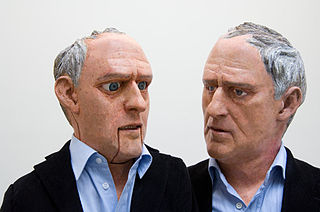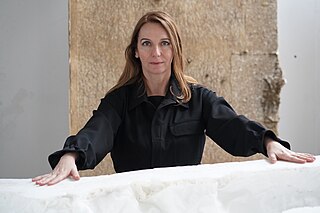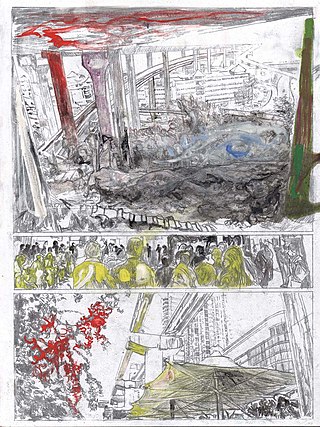
Thorsten Goldberg born 26 December 1960 in Dinslaken is a German multimedia artist.

Thorsten Goldberg born 26 December 1960 in Dinslaken is a German multimedia artist.
From 1982 to 1991 Thorsten Goldberg studied sculpture at the State Academy of Fine Arts in Stuttgart in the class of Inge Mahn. In 1991 he won the first prize of the Forum of Young Art for his photographic work, "Class of 97" with exhibition stations at Kunsthalle Kiel, Kunstverein Mannheim, Kunstmuseum Wolfsburg, Württembergischer Kunstverein Stuttgart and Staatliche Kunsthalle Baden-Baden. Along with the screenwriter Wieland Bauder he created the fictional character Thomas Bauer for joint artistic performances. When Thomas Bauer received the scholarship for photography by the Berlin Senate in 1991, he then took part in the art exhibition “Art on a world scale” at the Kunsthalle Kiel in 1993. Since 1995 and in addition to photographs and video works Thorsten Goldberg has been creating site-specific works and public art. He realized numerous projects in public space throughout Germany, in Poland, Norway and Canada and taught at various academies. 2003 - 2008 he was Adjunct Professor for Art in Public Space at the Art Academy Linz/AT and 2007 - 2009 Professor (repress.) for arts and media at the Muthesius Art Academy Kiel/Germany.
As a member of different committees and advisory boards he is involved in the election and organisation of competitions for art in public. Thorsten Goldberg is Initiator and Co-Publisher of „Public Art Wiki“, a Germany-wide internet archive for art in public space in the German-speaking-area (http://www.publicartwiki.org) He is also Co-Publisher of „Kunst in der Großsiedlung (art in the large-housing-area) Marzahn-Hellersdorf“ a printed documentation of more than 460 public works and author of several texts on public art.
Thorsten Goldberg lives in Berlin/Germany.
Cities are all in Germany unless otherwise noted.
| Year | Location | Venue | Type | Exhibition | Notes | Ref |
|---|---|---|---|---|---|---|
| 1985 | Stuttgart | Kuenstlerhaus | Solo | media exposure | ||
| 1989 | half the rent | |||||
| 1991 | Public space | going home, being home, staying home | 10 billboards | |||
| 1992 | Württembergischer Kunstverein | Solo | one weekend | |||
| 1993 | Berlin | Wohnmaschine Galerie Friedrich Loock | ||||
| Kirchheim | Gallery Noeth | Glamor and Misery | ||||
| Kiel | Kunsthalle Kiel | Public space | International sculpture | |||
| 1994 | Berlin | Wohnmaschine Galerie Friedrich Loock | Solo | |||
| 1995 | Heidenheim | Museum of Fine Arts | schmutz | |||
| 1996 | Hellersdorf | Permanent installation | reichweite, griffhoehe | |||
| Berlin | Wohnmaschine Galerie Friedrich Loock | Solo | remotes | |||
| Senate of Culture | senatorial chair | |||||
| Münster | Wewerka Pavillon | birdies | ||||
| 1997 | Lüdenscheid | Central Square | Public space | big game (hunt) | Collaboration with A. Kaufmann and B. Reitermann) | |
| Berlin | Permanent installation | Rock-Paper-Scissors | Randomized neon signs as a permanent marking of the former frontier crossing point | |||
| Wohnmaschine Galerie Friedrich Loock | Solo | birdies inside | ||||
| 1998 | Heidenheim | Kunstmuseum Heidenheim | Permanent installation | Once very much of all | Sculpture and planting in Levillain-Park | |
| Wiesbaden | Bellevuegallery | Solo | ||||
| 1999 | Gallery Hafemann | |||||
| 2000 | Public space | Hunger and Thirst, Cola and Sausage | Intervention with three singers, sculpture project | |||
| Potsdam | stand-by Potsdam | Horizontal gas flame on a chimney of a fallow industrial area | ||||
| 2001 | Bergkamen-Heil | Temporary sculpture | concierge | Brick doorpost with integrated plate and entryphone | ||
| Warsaw, Poland | XX1 Gallery | Solo | ||||
| 2002 | Eberswalde | State Hospital | Permanent installation | curtain mov. | Slow moving curtain, kinetic installation | |
| finger walks | Video installation on 5 large TFT Panels | |||||
| Münster | Exhibition Hall | Solo | detached village | |||
| Wiesbaden | Gallery Hafemann | |||||
| Marseille, France | Gallery RLBQ | generic profile | ||||
| Berlin | Gallery HO | HEINZGERDKURTKLAUS | ||||
| 2003 | Unter den Linden | Public space | milk & honey | Historical map of the land of milk and honey as a large back light display | ||
| 2004 | Heidenheim | Hauptstraße | next stop - milk & honey | |||
| 2005 | Wismar | Wismar depot | Neon writing on a shallow storage building in the old harbour | |||
| Barcelona, Spain | Fundació Joan Miró - Espai 13 | Solo | things are generally different behind closed doors | |||
| 2006 | Wiesbaden | Temporary installation | Rivers of wine and beer | Neon sculpture | ||
| Berlin | Charité Hospital | Public space | Inventory | Historical busts and bases | ||
| 2009 | Lippstadt | Lichtpromenade-Lichtkunst-Skulpturenpfad | Cumulus 08.07 | Neon-sculpture | ||
| 2010 | Berlin | WHITECONCEPTS | Solo | Constructing clouds | ||
| Potsdamer Strasse | Public space | die Potsdamer | film production Horsewoman | |||
| Federal Ministry of Food and Agriculture | Cumulus Berlin | Sculpture | ||||
| Ratingen | Museum for History of the City | milk & honey | ||||
| 2012 | Bergen, Norway | 60°N 05°E (encased waterside) | Land art and light sculpture | |||
| Neumünster | Herbert-Gerisch Sculpture Park | Cumulus 11.08 | Sculpture | |||
| Solo | 54°4 min. | |||||
| 2013 | Viersen | Municipal Gallery | 51°15 min. | |||
| Gdańsk, Poland | Laznia Centre for Contemporary Art | 54°24 min. | ||||
| Nadmorski Park | Public space | And honey upon hawthorn grows | Sculpture | |||
| 2014 | Radom, Poland | Mazovia Region Centre of Contemporary Art “Elektrownia” | Radom Cumulus | Light sculpture made of 19 layers of curved neon contours | ||
| 2015 | Bonn | Kreuzbauten, Federal Ministry for Digital and Transport | reflected ministry | Interactive video projections | ||
| 2016 | Neuhausen | Technisches Hilfswerk | 20.000 Morgen | 32 silver-plated landscape-models at a scale of 1:50.000 for the new building of a guest house | ||
| 2017 | Orońsko, Poland | Center of Polish Sculpture | The opera ain’t over till the fat lady sings | Sculpture | ||
| Solo | Constructing Clouds | |||||
| 2018 | Berlin-Marzahn-Hellersdorf | Public space | 24 kt | A bird's nest, cast of fine gold and a contract serve as a foundation for a new primary school | ||
| 2020 | Edmonton, Canada | North East Transit Garage | 53°30’N | Five topographic models of mountain landscapes |
Kunstverein may refer to:

Josephine Meckseper is a German-born artist, based in New York City. Her large-scale installations and films have been exhibited in various international biennials and museum shows worldwide.
Adam Saks is a Danish painter who lives and works in Berlin.

Stefan Banz was an artist and curator.

Ian McKeever is a contemporary British artist. Since 1990 McKeever has lived and worked in Hartgrove, Dorset, England.
Elmar Hess is a German artist.

Stephan Huber is a German sculptor and object artist.
Ursula Neugebauer is a German artist.
Karin Sander is a German conceptual artist. She lives and works in Berlin and Zurich.
Yury Kharchenko is a Russian German artist. He lives and works in Berlin.

Asta Gröting is a contemporary artist. She works in a variety of media like sculpture, performance, and video. In her work, Gröting “is conceptually and emotionally asking questions of the social body by taking something away from it and allowing this absence to do the talking.”

Stefan Ettlinger is a German painter and draughtsman. He studied at the Kunstakademie Düsseldorf at Alfonso Hüppi as a master student. He lives and works in Düsseldorf.
Wulf Herzogenrath, Germany is a German art historian and art curator. He is a leading expert in the fields of Video art, New Media Art and the Bauhaus. He has assembled a large collection of artist's books.

Byung Chul Kim is a South Korean artist based in Germany since 2004. He works in performance, drawing, painting and video.
Peter Zimmermann is a German painter, sculptor, object artist and university professor.
Achim Zeman is a German painter and installation artist. He is known for his extensive spatial installations that stretch across walls and floors and challenge our perception: "Verunsicherung der Betrachterposition, Irritation des Raumgefühls, Desorientierung – all das sind mögliche Umschreibungen für die Wirkung, die Achim Zeman mit seinen installativen Arbeiten erzielt.“ The space altered by Zeman's painterly interventions not only reflects the increasing insecurity experienced by society in recent years, but also enables viewers - precisely because the irritation is caused by artistic, aesthetic means - to engage with it in the first place and to experience uncertainty and changes in perspective not as threatening, but as inspiring.

Wiebke Siem is a German mixed media artist of German and Polish heritage, winner of the prestigious Goslarer Kaiserring in 2014 as "one of the most innovative and original artists who has never compromised in their art and whose sculptures have a tremendous aura and presence because they mix the familiar and the unfamiliar, the known and the unknown".
Ulrich Erben is a German painter. From 1980 to 2005, he was a Professor of Painting at the Kunstakademie Münster. He is known as a master of the color field style of abstract painting, closely related to abstract expressionism, in which he creates tension between a defined surface structure, his own method of applying paint to a canvas, and the relationship of various shades of white or color to each other in their placement as part of a composition on the flat plane of a canvas. In 1986 and 2008, he was awarded the Konrad-von-Soest Prize for Visual Arts by the Landschaftsverband Westfalen-Lippe.
Ines Doujak is an Austrian artist. Doujak graduated from Hochschule für angewandte Kunst in Vienna. She had her first solo exhibition in 2002 at the Vienna Secession in 2002. as part of which she took part in the Rainbow Parade of that year, the Viennese counterpart to the Christopher Street Day, for which she designed a float. Since then has exhibited worldwide ever since working with a variety of media: collage, sculpture, photography, film, audio and installation.
Reinhard Voigt is a German painter and ceramist.